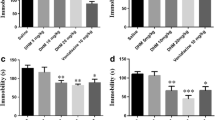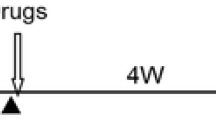Abstract
Objective
To investigate the therapeutic effect of Yixin Ningshen Tablet (YXNS) on comorbidity of myocardial infarction (MI) and depression in rats and explore the underlying mechanism.
Methods
The Sprague-Dawley rats were randomly divided into 5 groups with 7 rats in each group according to their weights, including control, model, fluoxetine (FLXT, 10 mg/kg), low-dose YXNS (LYXNS, 100 mg/kg), and high-dose YXNS (HYXNS, 300 mg/kg) groups. All rats were pretreated with corresponding drugs for 12 weeks. The rat model of MI and depression was constructed by ligation of left anterior descending coronary artery and chronic mild stress stimulation. The echocardiography, sucrose preference test, open field test, and forced swim test were performed. Myocardial infarction (MI) area and myocardial apoptosis was also detected. Serum levels of interleukin (IL)-6, IL-1β, tumor necrosis factor-α (TNF-α), 5-hydroxytryptamine (5-HT), adrenocorticotrophic hormone (ACTH), corticosterone (CORT), and norepinephrine (NE) were determined by enzyme linked immunosorbent assay. The proteins of adenosine 5′-monophosphate -activated protein kinase (AMPK), p-AMPK, peroxisome proliferator-activated receptor gamma coactivator-1α (PGC-1α), and nuclear respiratory factor 1 (NRF1) in heart were detected by Western blot analysis. The expression levels of TNF-α, IL-6, indoleamine 2,3-dioxygenase (IDO1), kynurenine 3-monooxygenase (KMO), and kynureninase (KYNU) in hippocampus were detected by real-time quantitative polymerase chain reaction.
Results
Compared with the model group, the cardiac function of rats treated with YXNS improved significantly (P<0.01). Meanwhile, YXNS effectively reduced MI size and cardiomyocytes apoptosis of rats (P<0.01 or P<0.05), promoted AMPK phosphorylation, and increased PGC-1α protein expression (P<0.01 or P<0.05). HYXNS significantly increased locomotor activity of rats, decreased the levels of TNF-α, IL-6 and IL-1β, and increased the serum levels of 5-HT, NE, ACTH, and CORT (all P<0.05). Moreover, HYXNS decreased the mRNA expressions of IDO1, KMO and KYNU (P<0.05).
Conclusions
YXNS can relieve MI by enhancing myocardial energy metabolism. Meanwhile, YXNS can alleviate depression by resisting inflammation and increasing availability of monoamine neurotransmitters. It may be used as a potential drug to treat comorbidity of MI and depression.
Similar content being viewed by others
References
Liu MY, Ren YP, Zhang LJ, Ding JY. Pretreatment with ginseng fruit saponins affects serotonin expression in an experimental comorbidity model of myocardial infarction and depression. Aging Dis 2016;7:680–686.
Carney RM, Freedland KE. Depression, mortality, and medical morbidity in patients with coronary heart disease. Biol Psychiatry 2003;54:241–247.
Cooney MT, Kotseva K, Dudina A, De Backer G, Wood D, Graham I. Determinants of risk factor control in subjects with coronary heart disease: a report from the EUROASPIRE III investigators. Eur J Prev Cardiol 2013;20:686–691.
Thombs BD, Bass EB, Ford DE, Stewart KJ, Tsilidis KK, Patel U, et al. Prevalence of depression in survivors of acute myocardial infarction. J Gen Intern Med 2006;21:30–38.
Williams MS. Platelets and depression in cardiovascular disease: a brief review of the current literature. World J Psychiatry 2012;2:114–123.
Glassman A. Depression and cardiovascular disease. Pharmacopsychiatry 2008;41:221–225.
Glassman AH, BiggerJr JT, Gaffney M. Psychiatric characteristics associated with long-term mortality among 361 patients having an acute coronary syndrome and major depression: seven-year follow-up of SADHART participants. Arch Gen Psychiatry 2009;66:1022–1029.
Whooley MA, Wong JM. Depression and cardiovascular disorders. Annu Rev Clin Psychol 2013;9:327–354.
Seligman F, Nemeroff CB. The interface of depression and cardiovascular disease: therapeutic implications. Ann N Y Acad Sci 2015;1345:25–35.
Kim HJ, Kim P, Shin CY. A comprehensive review of the therapeutic and pharmacological effects of ginseng and ginsenosides in central nervous system. J Ginseng Res 2013;37:8–29.
Lee CH, Kim JH. A review on the medicinal potentials of ginseng and ginsenosides on cardiovascular diseases. J Ginseng Res 2014;38:161–166.
Shi SB, Liang JJ, Liu T, Yuan XR, Ruan Bi, Sun LF, et al. Depression increases sympathetic activity and exacerbates myocardial remodeling after myocardial infarction: evidence from an animal experiment. PLoS One 2014;9:e101734.
Pfeffer JM, Pfeffer MA, Braunwald E. Influence of chronic captopril therapy on the infarcted left ventricle of the rat. Circ Res 1985;57:84–95.
Wu RM, Jiang B, Li H, Dang WZ, Bao WL, Li HD, et al. A network pharmacology approach to discover action mechanisms of Yangxinshi Tablet for improving energy metabolism in chronic ischemic heart failure. J Ethnopharmacol 2020;246:112227.
Grønli J, Murison R, Fiske E, Bjorvatn B, Sørensen E, Portas CM, et al. Effects of chronic mild stress on sexual behavior, locomotor activity and consumption of sucrose and saccharine solutions. Physiol Behav 2005;84:571–577.
Aronsen JM, Espe EKS, Skardal K, Hasic A, Zhang L, Sjaastad I. Noninvasive stratification of postinfarction rats based on the degree of cardiac dysfunction using magnetic resonance imaging and echocardiography. Am J Physiol Heart Circ Physiol 2017;312:H932–H942.
Porsolt RD, Pichon ML, Jalfre M. Depression: a new animal model sensitive to antidepressant treatments. Nature 1977;266:730–732.
Wang Y, Liu J, Ma A, Chen Y. Cardioprotective effect of berberine against myocardial ischemia/reperfusion injury via attenuating mitochondrial dysfunction and apoptosis. Int J Clin Exp Med 2015;8:14513–14519.
Lin S, Chu JF, Zhang L, Chen DX, Xiao F, Chen HW, et al. Protective effects of Shexiang Tongxin Dropping Pill on pituitrininduced acute myocardial ischemia in rats. Mol Med Rep 2017;16:3125–3132.
Huffman JC. Review: depression after myocardial infarction is associated with increased risk of all-cause mortality and cardiovascular events. Evid Based Ment Health 2013;16:110.
Kim YH, Kim SH, Lim SY, Cho GY, Baik IK, Lim HE, et al. Relationship between depression and subclinical left ventricular changes in the general population. Heart 2012;98:1378–1383.
van Melle JP, de Jonge P, Ormel J, Crijns HJGM, van Veldhuisen DJ, Honig A, et al. Relationship between left ventricular dysfunction and depression following myocardial infarction: data from the MIND-IT. Eur Heart J 2005;26:2650–2656.
Nakatani S. Echocardiography. Nihon Rinsho 2006;64:867–873.
de Silva M, Mihailovic A, Toaldo MB. Two-dimensional, M-mode, and Doppler echocardiography in 22 conscious and apparently healthy pet guinea pigs. J Vet Cardiol 2020;27:54–61.
Lee B, Choi GM, Sur B. Antidepressant-like effects of hesperidin in animal model of post-traumatic stress disorder. Chin J Integr Med 2021;27:39–46.
Hirschfeld RM. History and evolution of the monoamine hypothesis of depression. J Clin Psychiatry 2000;61(Suppl 6):4–6.
Maddison DC, Giorgini F. The kynurenine pathway and neurodegenerative disease. Semin Cell Dev Biol 2015;40:134–141.
Campbell BM, Charych E, Lee AW, Moller T. Kynurenines in CNS disease: regulation by inflammatory cytokines. Front Neurosci 2014;8:12.
Zunszain PA, Anacker C, Cattaneo A, Choudhury S, Musaelyan K, Myint AM, et al. Interleukin-1beta: a new regulator of the kynurenine pathway affecting human hippocampal neurogenesis. Neuropsychopharmacology 2012;37:939–949.
Connor TJ, Starr N, O’sullivan JB, Harkin A. Induction of indolamine 2,3-dioxygenase and kynurenine 3-monooxygenase in rat brain following a systemic inflammatory challenge: a role for IFN-gamma? Neurosci Lett 2008;441:29–34.
Molteni R, Macchi F, Zecchillo C, Dell’agli M, Colombo E, Calabrese F, et al. Modulation of the inflammatory response in rats chronically treated with the antidepressant agomelatine. Eur Neuropsychopharmacol 2013;23:1645–1655.
Siricilla S. High-throughput assay development for combined in vitro toxicity screening of hit compounds and their metabolites in early drug-discovery stage. Bioanalysis 2017;9:959–961.
Janzen WP. Screening technologies for small molecule discovery: the state of the art. Chem Biol 2014;21:1162–1170.
Author information
Authors and Affiliations
Contributions
Shen XY and Ye G designed the experiments; Jiang B, Li H, Dang WZ, Li K, Li HD, and Bao WL performed the experiments; Jiang B and Feng GZ analyzed and interpreted the data; Jiang B and Wu RM wrote the manuscript. All authors discussed the results and commented on the manuscript.
Corresponding author
Ethics declarations
The authors declare that they have no competing interests.
Additional information
Supported by the Science and Technology Commission of Shanghai Municipality (No. 15DZ1900103, 15DZ1900100)
Rights and permissions
About this article
Cite this article
Jiang, B., Wu, Rm., Li, Hd. et al. Yixin Ningshen Tablet Alleviates Comorbidity of Myocardial Infarction and Depression by Enhancing Myocardial Energy Metabolism and Increasing Availability of Monoamine Neurotransmitter. Chin. J. Integr. Med. 28, 586–593 (2022). https://doi.org/10.1007/s11655-022-3570-3
Accepted:
Published:
Issue Date:
DOI: https://doi.org/10.1007/s11655-022-3570-3




